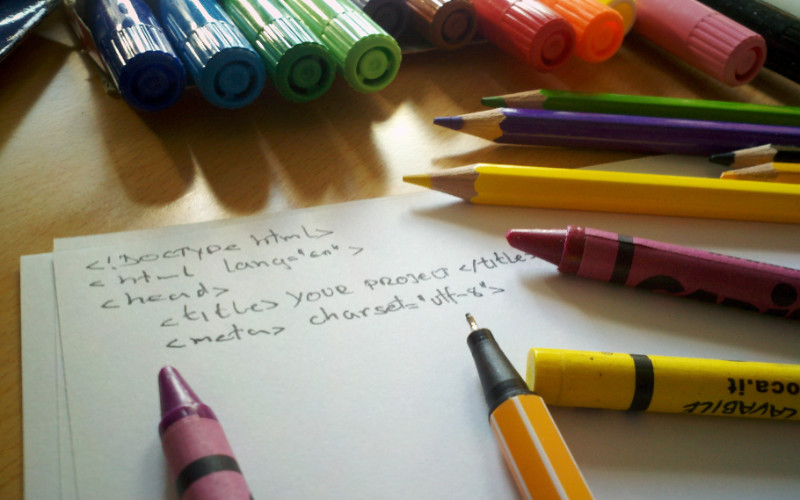On Machines
TJ Jarrett
For the last 20 years, I’ve made my living developing software. It is sometimes hard, often rewarding work. I’ve never really had issues with programming per se. That’s just writing a set of instructions to perform a certain action. Do action A, then B, maybe do A again, then C. It’s an exercise in logic. For the first year or so that I did this, I thought the problem facing the technologist was the about the means of our creation: HOW we write programs, HOW the machines we use are built, or HOW we optimize them to run faster and more efficiently.
But as I honed my skills and became confident in them, I realized the root problem of technology. It’s people. I can build anything and that’s the very problem. If I’m building something, I would kindly like someone to tell me what it is that I’m supposed to be building. I’d like a set of requirements (or features) and an expectation of what the end user needs me to accomplish. If I don’t know what to accomplish, it doesn’t much matter how I accomplish it. Everyone will be disappointed.
Facts: Machines are dumb. Machines do exactly what we tell them; they are blunt instruments that follow our instructions blindly. This makes them at least as dumb as we are. Think of that the next time you yell at your cell phone app. It’s not the machine—it’s the programmer. You’re mad at a *person*. Don’t kick the TV. Find a person. Kick them. That machine did nothing to you.
All this complaint about machine code and my job is to say this: I learned as much of my discipline in writing poems from writing code as I did in grad school learning writing. For example, you learn about writing code by looking at other’s code, other’s solutions to problems, and other algorithms. Another example: much of my time in code is spent building equivalencies—building objects and making equivalencies. One does this all the time in poems when one is leveraging an image, figuring out what a certain image brings to the poem and thinking of how to use it as metaphor. Metaphor is simply building equivalence and simile is calling attention to that equivalence. But most importantly, I learned to keep my eye on the purpose. To do my best work, there is a time for composition and creativity but also a place to focus on the features and requirements of my creation. Each craft is granted tools, and to each technician, choices arise in the use of those tools for the intended effect.
For this, I will be using a poem that is based on programming due to the conditions under which I wrote it. I was working on a project and as I was designing, I realized exactly the container I wanted to build to hold the emotions I had for the subject.
After Forty Days, Go Marry Again
Beslan School No. 1, September 1, 2004
She was only just here. That’s her,
that’s her in the red dress, that’s
her, too, fists full of balloons as if
she would fly away. That’s her at the
bottom of the hill. She ran as fast as she
could toward the top, arms wide,
cheeks flushed. She reached me
breathless and toppled both of us.
That’s her, and her again,
her black hair in pigtails held
in yellow ball-stay barrettes.
Girls of that age are particular
about such things. I sleep in her room
some nights with all the lights on,
everything as she left it.
There she is in Rostov, there she is
and there she is and there she is.
There she is: bits of black hair
and the earrings. They say: maybe
that’s not her. Look. There.
The ball-stay barrettes. Yellow,
flowers stretched around. There she
is at Christmas. There she is that
summer she grew three inches. They say:
after forty days, go marry again. But
there she is, and there she is again with
her friend from class. That girl is dead too.
There she is at the carnival. There she is.
Her fists clenched on the balloons. There
she is at the door, lunchbox in one hand,
waving with the other. At night,
I pretend to sleep; there she is
standing over me as if there are words
left to say. There she is. There
she is in the dark.
<<After 40 Days, Go Marry Again: TJ Jarrett in Zion, SIU Press 2014>>
On Building a Machine
As Dobyns points out “a poem is a machine made out of words.” Years before, I had read an article about the Beslan School Siege in 2004. An interviewer was circling back to talk to the families and one of the parents invited the crew into his home and showed pictures of his daughter and wife who had been killed. The article slayed me, but I didn’t know how to talk about it. I’d started and stopped several times and couldn’t seem to get anywhere without it becoming too sentimental or imposing how *I* felt about the massacre instead of how the victims felt about it. I had read the article again a day or so before I did this rewrite and then I was stuck in my office having to retool an algorithm that directed clients to health clinics that are near their home addresses. Part of building it is simply submitting the address to the map engine, but there were other considerations: Who was this person’s primary care provider, which insurance did the patient carry, which facility had more favorable rates for that insurer and we would produce a ranked list of facilities based on these characteristics.
So, the code works as follows—you submit to a procedure that has several input variables and you list each one:
Address = XXXX
ZipCode = XXX
Insurer = XXX
Plan = XXX
ProviderNDC = XXX
And while walking through the code, you would see how I would model the decision tree that built the rankings: First you process the address to get a discrete list of clinics and then you pass in the insurer information to rank this list by rate and then pass in the provider information to sort again for the facilities where that provider has privileges.
As I was working on that code, the idea hit me that I could bring some of this to the poem. The anaphora “That’s her” and “There she is” could be deployed to take me, the writer of the poem, as far out of frame as possible. I could take some of the words that the father used in the interview: “That’s her, black hair… held in yellow ball-stay barrettes” and propel his loss by building this nameless girl by building a list of her characteristics (what I would call populating an attribute list in CS language). The poem then becomes propelled by facts which are poignant enough without my meddling. I moved from “That’s her” to “There she is” to bring the frame in closer to the subject without seeming too familiar.
This example is not about cleverness—it is to show how interconnected disciplines are and how these dumb machines need someone to explain them. How connected you, dear reader— my end user— are to the creator of the software/poem that I intend you to use. I could not afford to lose sight of what a reader would understand, and I shifted and re-sorted the details for this nameless little girl many times before I could reach a solution that satisfied me. This piece (and most pieces for me) are hinged on organizational principles and logic as much (and often more) than sentiment. This doesn’t build ‘mechanical’ feeling poems. I simply find that the feeling seems to build by itself if the subject of the poem is already clear. I don’t have problem feeling things; I have problems explaining them to others.
***
People often want to see the world as zero-sum game between the humanities and STEM. A thousand movies have been made about machine revolutions. What gets lost in this is that machines are here to serve us and there is always an architect, another human (or <<shudder>> a committee), who is responsible for the instructions of this machine. The emotions we ascribe to them are premature anthropomorphizing. There still exists many exciting things that machines can bring to us—real time translation for example—and there exist many perils—our constant surveillance that we seem to dismiss as necessary. The issues that technology bring us are *human* problems that require *human* solutions. For this we need the instruction that history and art bring us to explain this world we create to ourselves. We must be vigilant in wielding technologies power to democratize (see Twitter & Facebook) our voices as well as technology’s power to oppress.
If nothing else of importance is found in this discussion, I want you to remember this:
- Kick the programmer, not the machine
- We own our code and we own the decisions we make with it. If an adverse decision is made, then we can (and should) unmake these decisions. To live in a world that depends so much on machines, we need to understand their inner workings. To fail to do so make us poorer and dependent in a way that invites abuse.
And one more thing: let’s keep doing that one thing that humans do—feeling, empathizing, understanding one another. Isn’t the purpose of writing to relay these feelings to one another? To see through the eyes of another? Let us not be afraid of technology—if we are afraid, we should be afraid of our diminishing humanity. That work is the most important thing we are called to do while we are yet alive. Feel more deeply. Think more deeply. Spend more time discovering the world around you. Tell someone about it. We are on earth too short a time to worry about our tools. Let us focus again on our purpose. What art brings to us is far more important than tools we employ to build it.
Provenance: Contribution
 TJ Jarrett is a writer and software developer in Nashville, Tennessee. Her recent work has been published or is forthcoming in Poetry, African American Review, Boston Review, Beloit Poetry Journal, Callaloo, DIAGRAM, Third Coast, VQR, West Branch and others. She has earned scholarships from Colrain Manuscript Conference and Vermont Studio Center; fellowships from Sewanee Writer’s Conference 2014 and the Summer Literary Seminars 2012 and 2014; winner of VQR’s Emily Clark Balch Prize for Poetry 2014; a runner up for the 2012 Marsh Hawk Poetry Prize and 2012 New Issues Poetry Prize; and her collection The Moon Looks Down and Laughs was selected as a finalist for the 2010 Tampa Review Prize for Poetry. She has been anthologized in Language Lessons by Third Man Books and Best American Non-Required Reading 2015 from Houghton-Mifflin and others. She was awarded the 2017 George Garrett New Writing Award by the Fellowship of Southern Writers. Her debut collection Ain’t No Grave (finalist for the 2013 Balcones Prize) was published with New Issues Press (2013). Her second collection Zion (winner of the Crab Orchard Open Competition 2013) was published by Southern Illinois University Press in the fall of 2014.
TJ Jarrett is a writer and software developer in Nashville, Tennessee. Her recent work has been published or is forthcoming in Poetry, African American Review, Boston Review, Beloit Poetry Journal, Callaloo, DIAGRAM, Third Coast, VQR, West Branch and others. She has earned scholarships from Colrain Manuscript Conference and Vermont Studio Center; fellowships from Sewanee Writer’s Conference 2014 and the Summer Literary Seminars 2012 and 2014; winner of VQR’s Emily Clark Balch Prize for Poetry 2014; a runner up for the 2012 Marsh Hawk Poetry Prize and 2012 New Issues Poetry Prize; and her collection The Moon Looks Down and Laughs was selected as a finalist for the 2010 Tampa Review Prize for Poetry. She has been anthologized in Language Lessons by Third Man Books and Best American Non-Required Reading 2015 from Houghton-Mifflin and others. She was awarded the 2017 George Garrett New Writing Award by the Fellowship of Southern Writers. Her debut collection Ain’t No Grave (finalist for the 2013 Balcones Prize) was published with New Issues Press (2013). Her second collection Zion (winner of the Crab Orchard Open Competition 2013) was published by Southern Illinois University Press in the fall of 2014.
Featured Image: “crayons and coding” by Aleksandar Cocek is licensed under CC BY-SA 2.0


No Comments